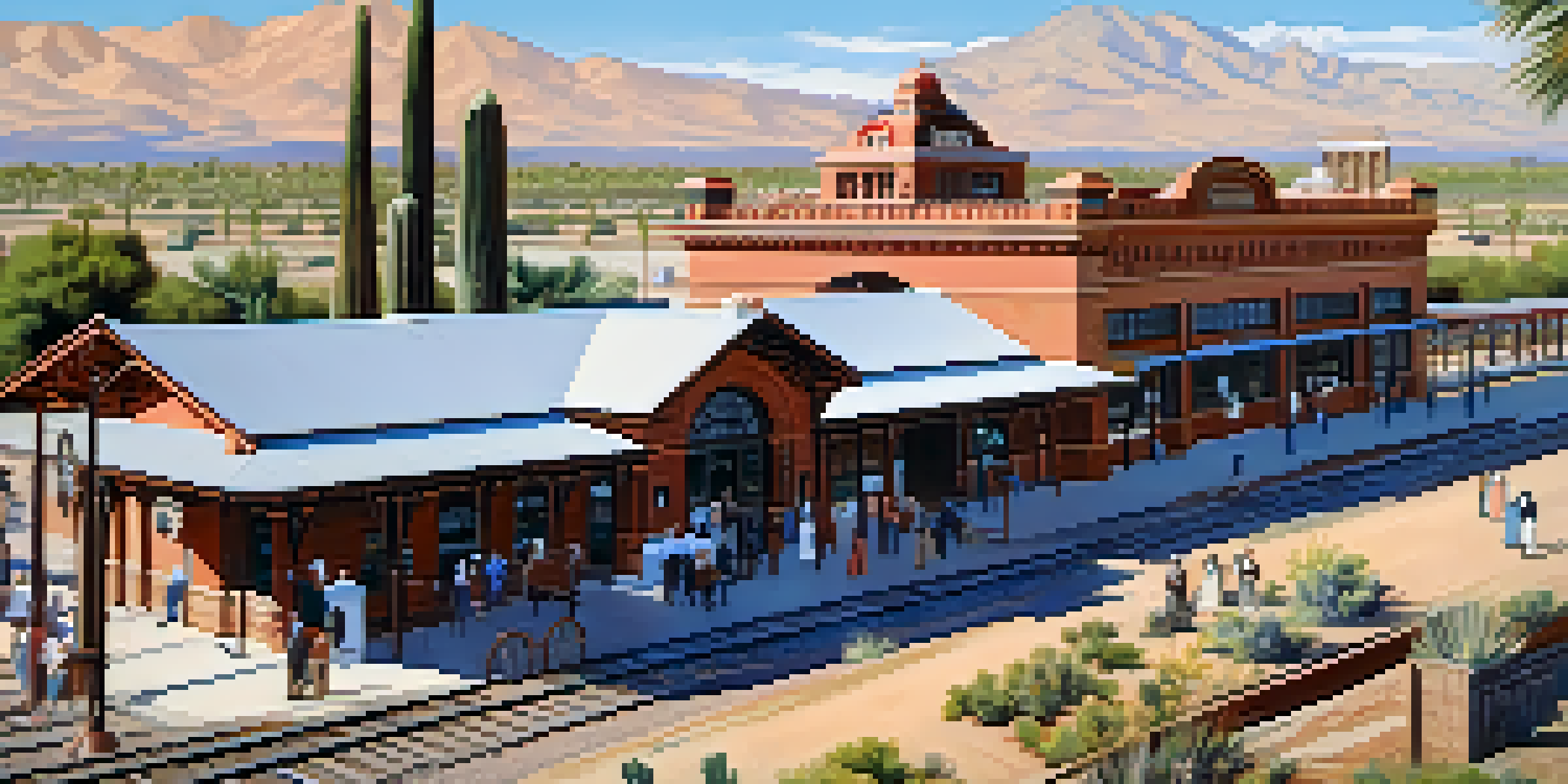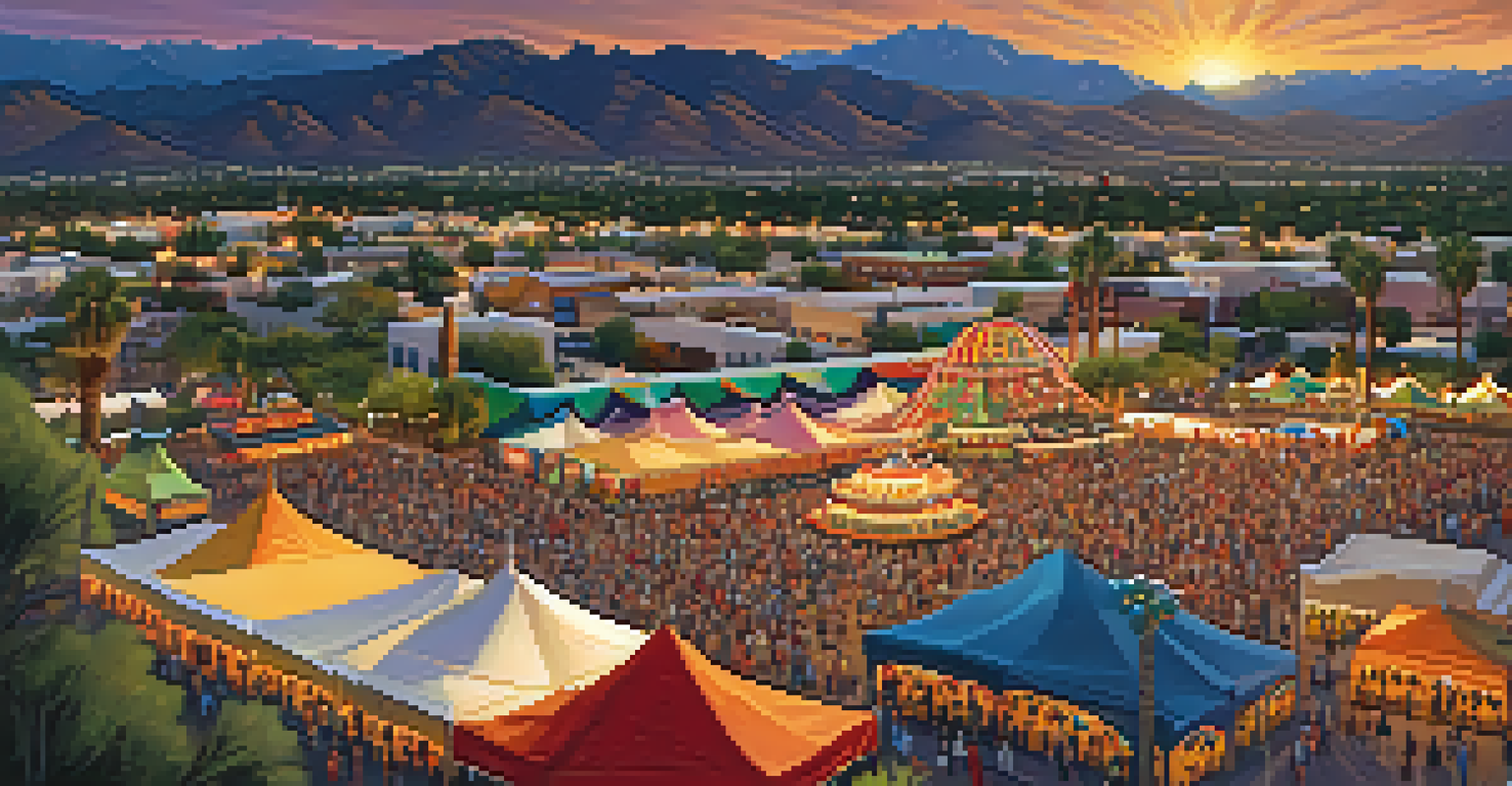Tucson Railroads and Their Influence on Local Culture

The Birth of Railroads in Tucson: A Historical Overview
Tucson's railroad history dates back to the late 19th century, marking a significant turning point for the city. The arrival of the Southern Pacific Railroad in 1880 transformed Tucson from a sleepy desert town into a bustling hub of commerce and travel. This new connectivity not only facilitated trade but also attracted a diverse population, eager to explore the opportunities that came with the railroads.
The railroad is a more efficient way to transport goods than any other means, and it fosters economic growth and community development.
As trains began to crisscross the landscape, they brought with them new ideas, cultures, and goods. The influx of settlers and travelers created a melting pot environment, where different traditions began to mix and evolve. This early blending laid the groundwork for Tucson's unique cultural identity, which is still evident today.
Moreover, the railroads played a crucial role in expanding Tucson’s economy. Businesses sprouted up around the train stations, and the city became a vital point for transportation across the Southwest. This growth set the stage for Tucson’s development as a cultural and economic center in the region.
Cultural Exchange: How Railroads Connected Communities
The railroads served as a bridge, connecting Tucson with other cities and communities across Arizona and beyond. This connectivity facilitated not just the exchange of goods, but also cultural practices and traditions. Festivals, music, and art from various regions began to flow into Tucson, enriching its local culture.

For example, the influence of Mexican culture became particularly pronounced as the railroads linked Tucson to Mexico. Food, music, and festivals such as Día de los Muertos incorporated elements from both sides of the border, creating a vibrant tapestry of cultural expression. This blend of influences has made Tucson a hub for cultural celebrations, showcasing its diverse roots.
Railroads Transformed Tucson's Economy
The arrival of railroads in Tucson catalyzed economic growth, facilitating trade and expanding job opportunities.
Additionally, railroads allowed for easier travel, enabling residents to explore and experience the wider world. This exchange helped foster a sense of unity among different groups, as they shared their stories and customs, further weaving the social fabric of Tucson.
Economic Impacts: The Link Between Railroads and Prosperity
The economic impact of railroads on Tucson cannot be overstated; they were the lifeblood of local commerce. As goods moved in and out more efficiently, businesses thrived, providing jobs and boosting the local economy. This economic boom helped secure Tucson's position as an essential trade center in the Southwest.
Railroads are the arteries of a nation; they connect communities and create opportunities for cultural exchange.
Moreover, the availability of transportation led to agricultural expansion in the surrounding areas. Farmers could easily ship their products to larger markets, which in turn increased agricultural diversity and production. This shift not only enriched Tucson’s economy but also ensured a steady supply of fresh produce for its residents.
In essence, the railroads catalyzed Tucson's growth, creating a ripple effect of economic opportunities that benefited the entire region. The wealth generated during this time laid the foundation for future developments, paving the way for Tucson to evolve into the vibrant city it is today.
Architectural Influences: Railroads Shaping Tucson's Landscape
The arrival of railroads in Tucson influenced not just the economy but also the city's architecture and layout. Train stations became focal points, often designed with distinct architectural styles that reflected both functionality and beauty. The Southern Pacific Railroad station, built in the early 20th century, is a prime example of this blend of utility and aesthetics.
As the railroads brought in new materials and design ideas, Tucson's buildings began to evolve. Styles like Mission Revival and Territorial were influenced by the train's connectivity with other regions, incorporating elements that reflected a fusion of cultures. This architectural diversity adds to the visual charm of Tucson, making it a unique place to live and visit.
Cultural Exchange Through Connectivity
Railroads connected Tucson with diverse communities, enriching its culture through the exchange of traditions and practices.
These developments were not merely about practicality; they represented Tucson’s aspirations and growth. The city became a canvas, showcasing its history and culture through its structures, which continue to tell the story of how railroads shaped its identity.
Community Events: Railroads as Catalysts for Local Traditions
Railroads have also played a vital role in fostering community events and traditions in Tucson. The convenience of travel allowed residents to participate in festivals, fairs, and cultural gatherings that highlight the city's rich heritage. Events like the Tucson Rodeo and All Souls Procession draw inspiration from a mix of local and regional influences, showcasing the community's diverse roots.
In many ways, these events have become a celebration of the very cultures that the railroads helped to connect. They serve as a reminder of Tucson's historical journey and the shared experiences that have shaped its identity. The community comes together to honor these traditions, creating lasting memories and connections among residents.
The railroads have not just changed how people travel; they have deepened the sense of community. By bringing together various cultural influences and encouraging the celebration of these traditions, Tucson has crafted a vibrant local culture that continues to thrive.
Education and Railroads: Learning from the Past
The impact of railroads on Tucson extends into the realm of education, providing opportunities for learning about history, culture, and economics. Local museums and educational programs often highlight the role of railroads in shaping the community, helping residents and visitors alike understand their significance. The Southern Arizona Transportation Museum, for instance, showcases artifacts and stories that reflect this rich history.
Students in Tucson benefit from programs that explore the historical implications of railroads, fostering a deeper appreciation of their city’s past. This educational focus encourages younger generations to engage with their heritage, ensuring that the stories of the railroads are not forgotten. By learning about these influences, students can better understand how they fit into Tucson's ongoing narrative.
Railroads Shaped Tucson's Identity
The architectural and social developments driven by railroads have played a crucial role in defining Tucson's unique cultural landscape.
Ultimately, education about railroads serves as a vital link between the past and present. It helps cultivate a sense of pride in the community and inspires individuals to honor and preserve their cultural heritage for future generations.
Future Perspectives: Railroads and Tucson's Cultural Evolution
As Tucson continues to evolve, the influence of railroads remains an integral part of its cultural landscape. While modern transportation options have changed the way we travel, the historical significance of railroads still resonates within the community. New initiatives, such as heritage railroads and tourism, aim to celebrate this legacy while promoting sustainable practices.
Looking ahead, Tucson's railroads could play an essential role in shaping future cultural experiences. As the city embraces its history, there is a growing interest in reviving train travel and integrating it into new urban planning efforts. This could lead to a unique blend of the old and new, where railroads continue to connect people and cultures.

In this way, Tucson's railroads are not just relics of the past; they are part of an ongoing story. By honoring their influence and adapting to contemporary needs, the city can ensure that its cultural identity remains vibrant and dynamic, continuing to inspire both residents and visitors alike.